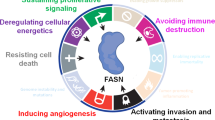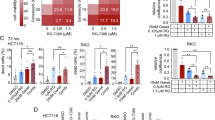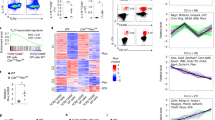Abstract
Heat shock protein 27 (Hsp27) is emerging as a promising therapeutic target for treatment of various cancers. Although the role of Hsp27 in protection from stress-induced intrinsic cell death has been relatively well studied, its role in Fas (death domain containing member of the tumor necrosis factor receptor superfamily)-induced apoptosis and cell proliferation remains underappreciated. Here, we show that Hsp27 silencing induces dual coordinated effects, resulting in inhibition of cell proliferation and sensitization of cells to Fas-induced apoptosis through regulation of PEA-15 (15-kDa phospho-enriched protein in astrocytes). We demonstrate that Hsp27 silencing suppresses proliferation by causing PEA-15 to bind and sequester extracellular signal-regulated kinase (ERK), resulting in reduced translocation of ERK to the nucleus. Concurrently, Hsp27 silencing promotes Fas-induced apoptosis by inducing PEA-15 to release Fas-associating protein with a novel death domain (FADD), thus allowing FADD to participate in death receptor signaling. Conversely, Hsp27 overexpression promotes cell proliferation and suppresses Fas-induced apoptosis. Furthermore, we show that Hsp27 regulation of PEA-15 activity occurs in an Akt-dependent manner. Significantly, Hsp27 silencing in a panel of phosphatase and tensin homolog on chromosome 10 (PTEN) wild-type or null cell lines, and in LNCaP cells that inducibly express PTEN, resulted in selective growth inhibition of PTEN-deficient cancer cells. These data identify a dual coordinated role of Hsp27 in cell proliferation and Fas-induced apoptosis via Akt and PEA-15, and indicate that improved clinical responses to Hsp27-targeted therapy may be achieved by stratifying patient populations based on tumor PTEN expression.
Similar content being viewed by others
Log in or create a free account to read this content
Gain free access to this article, as well as selected content from this journal and more on nature.com
or
Accession codes
Change history
17 March 2025
A Correction to this paper has been published: https://doi.org/10.1038/s41418-025-01478-8
Abbreviations
- Ask1:
-
apoptosis signal-regulating kinase 1
- BrdU:
-
bromodeoxyuridine
- CHX:
-
cycloheximide
- Daxx:
-
death-associated protein 6
- CMV:
-
cytomegalovirus
- DAPI:
-
4′,6′-diaminido-2-phenylindole
- Dox:
-
doxycycline
- Elk-1:
-
ETS-like transcription factor 1
- ERK:
-
extracellular signal-regulated kinase
- FADD:
-
Fas-associating protein with a novel death domain
- Fas (also known as Apo-1 or CD95):
-
death domain containing member of the tumor necrosis factor receptor superfamily
- GFP:
-
green fluorescent protein
- GSK3:
-
glycogen synthase kinase-3
- Hsp27:
-
heat shock protein 27
- p27kip1:
-
cyclin-dependent kinase inhibitor p27
- PBS:
-
phosphate-buffered saline
- PEA-15:
-
15-kDa phospho-enriched protein in astrocytes
- PI3K:
-
phosphatidylinositol 3-kinase
- PKB (also known as Akt):
-
protein kinase B
- PTEN:
-
phosphatase and tensin homolog on chromosome 10
- shRNA:
-
short hairpin RNA
- siRNA:
-
small interfering RNA
References
Garrido C, Brunet M, Didelot C, Zermati Y, Schmitt E, Kroemer G . Heat shock proteins 27 and 70: anti-apoptotic proteins with tumorigenic properties. Cell Cycle 2006; 5: 2592–2601.
Ciocca DR, Calderwood SK . Heat shock proteins in cancer: diagnostic, prognostic, predictive, and treatment implications. Cell Stress Chaperones 2005; 10: 86–103.
Rocchi P, So A, Kojima S, Signaevsky M, Beraldi E, Fazli L et al. Heat shock protein 27 increases after androgen ablation and plays a cytoprotective role in hormone-refractory prostate cancer. Cancer Res 2004; 64: 6595–6602.
Rocchi P, Beraldi E, Ettinger S, Fazli L, Vessella RL, Nelson C et al. Increased Hsp27 after androgen ablation facilitates androgen-independent progression in prostate cancer via signal transducers and activators of transcription 3-mediated suppression of apoptosis. Cancer Res 2005; 65: 11083–11093.
Kamada M, So A, Muramaki M, Rocchi P, Beraldi E, Gleave M . Hsp27 knockdown using nucleotide-based therapies inhibit tumor growth and enhance chemotherapy in human bladder cancer cells. Mol Cancer Ther 2007; 6: 299–308.
Garrido C, Fromentin A, Bonnotte B, Favre N, Moutet M, Arrigo AP et al. Heat shock protein 27 enhances the tumorigenicity of immunogenic rat colon carcinoma cell clones. Cancer Res 1998; 58: 5495–5499.
Rocchi P, Jugpal P, So A, Sinneman S, Ettinger S, Fazli L et al. Small interference RNA targeting heat-shock protein 27 inhibits the growth of prostatic cell lines and induces apoptosis via caspase-3 activation in vitro. BJU Int 2006; 98: 1082–1089.
Formstecher E, Ramos JW, Fauquet M, Calderwood DA, Hsieh JC, Canton B et al. PEA-15 mediates cytoplasmic sequestration of ERK MAP kinase. Dev Cell 2001; 1: 239–250.
Gaumont-Leclerc MF, Mukhopadhyay UK, Goumard S, Ferbeyre G . PEA-15 is inhibited by adenovirus E1A and plays a role in ERK nuclear export and Ras-induced senescence. J Biol Chem 2004; 279: 46802–46809.
Hill JM, Vaidyanathan H, Ramos JW, Ginsberg MH, Werner MH . Recognition of ERK MAP kinase by PEA-15 reveals a common docking site within the death domain and death effector domain. EMBO J 2002; 21: 6494–6504.
Manning BD, Cantley LC . AKT/PKB signaling: navigating downstream. Cell 2007; 129: 1261–1274.
Trencia A, Perfetti A, Cassese A, Vigliotta G, Miele C, Oriente F et al. Protein kinase B/Akt binds and phosphorylates PED/PEA-15, stabilizing its antiapoptotic action. Mol Cell Biol 2003; 23: 4511–4521.
Rhodes N, Heerding DA, Duckett DR, Eberwein DJ, Knick VB, Lansing TJ et al. Characterization of an Akt kinase inhibitor with potent pharmacodynamic and antitumor activity. Cancer Res 2008; 68: 2366–2374.
Renganathan H, Vaidyanathan H, Knapinska A, Ramos JW . Phosphorylation of PEA-15 switches its binding specificity from ERK/MAPK to FADD. Biochem J 2005; 390: 729–735.
Rokhlin OW, Bishop GA, Hostager BS, Waldschmidt TJ, Sidorenko SP, Pavloff N et al. Fas-mediated apoptosis in human prostatic carcinoma cell lines. Cancer Res 1997; 57: 1758–1768.
Sebolt-Leopold JS, Herrera R . Targeting the mitogen-activated protein kinase cascade to treat cancer. Nat Rev Cancer 2004; 4: 937–947.
Parsons R . Human cancer, PTEN and the PI-3 kinase pathway. Semin Cell Dev Biol 2004; 15: 171–176.
Weinstein IB, Joe AK . Mechanisms of disease: oncogene addiction--a rationale for molecular targeting in cancer therapy. Nat Clin Pract Oncol 2006; 3: 448–457.
Weinstein IB, Joe A . Oncogene addiction. Cancer Res 2008; 68: 3077–3080; discussion 3080.
Konishi H, Matsuzaki H, Tanaka M, Takemura Y, Kuroda S, Ono Y et al. Activation of protein kinase B (Akt/RAC-protein kinase) by cellular stress and its association with heat shock protein Hsp27. FEBS Lett 1997; 410: 493–498.
Rane MJ, Pan Y, Singh S, Powell DW, Wu R, Cummins T et al. Heat shock protein 27 controls apoptosis by regulating Akt activation. J Biol Chem 2003; 278: 27828–27835.
Mehlen P, Schulze-Osthoff K, Arrigo AP . Small stress proteins as novel regulators of apoptosis. Heat shock protein 27 blocks Fas/APO-1- and staurosporine-induced cell death. J Biol Chem 1996; 271: 16510–16514.
Charette SJ, Lavoie JN, Lambert H, Landry J . Inhibition of Daxx-mediated apoptosis by heat shock protein 27. Mol Cell Biol 2000; 20: 7602–7612.
Parcellier A, Brunet M, Schmitt E, Col E, Didelot C, Hammann A et al. HSP27 favors ubiquitination and proteasomal degradation of p27Kip1 and helps S-phase re-entry in stressed cells. FASEB J 2006; 20: 1179–1181.
Andrieu C, Taieb D, Baylot V, Ettinger S, Soubeyran P, De-Thonel A et al. Heat shock protein 27 confers resistance to androgen ablation and chemotherapy in prostate cancer cells through eIF4E. Oncogene 2010; 29: 1883–1896.
Lois C, Hong EJ, Pease S, Brown EJ, Baltimore D . Germline transmission and tissue-specific expression of transgenes delivered by lentiviral vectors. Science 2002; 295: 868–872.
Trougakos IP, So A, Jansen B, Gleave ME, Gonos ES . Silencing expression of the clusterin/apolipoprotein j gene in human cancer cells using small interfering RNA induces spontaneous apoptosis, reduced growth ability, and cell sensitization to genotoxic and oxidative stress. Cancer Res 2004; 64: 1834–1842.
Acknowledgements
This work was funded by the Cancer Research Society (CJO), Canadian Institutes of Health Research (CJO), NIH Pacific Northwest Prostate Cancer SPORE (MEG) and a NCIC Terry Fox New Frontiers Program Project Grant (MEG).
Author information
Authors and Affiliations
Corresponding author
Ethics declarations
Competing interests
This work was supported by grants from the National Cancer Institute of Canada, NIH Pacific Northwest Prostate SPORE and Canadian Institutes of Health Research.
Additional information
Edited by P Vandenabeele
Rights and permissions
About this article
Cite this article
Hayashi, N., Peacock, J., Beraldi, E. et al. Hsp27 silencing coordinately inhibits proliferation and promotes Fas-induced apoptosis by regulating the PEA-15 molecular switch. Cell Death Differ 19, 990–1002 (2012). https://doi.org/10.1038/cdd.2011.184
Received:
Revised:
Accepted:
Published:
Issue date:
DOI: https://doi.org/10.1038/cdd.2011.184
Keywords
This article is cited by
-
Host cell proteins modulated upon Toxoplasma infection identified using proteomic approaches: a molecular rationale
Parasitology Research (2022)
-
Adverse Effects of High Temperature On Mammary Alveolar Development In Vitro
Journal of Mammary Gland Biology and Neoplasia (2022)
-
Increased HSP27 correlates with malignant biological behavior of non-small cell lung cancer and predicts patient’s survival
Scientific Reports (2017)
-
Mammalian HspB1 (Hsp27) is a molecular sensor linked to the physiology and environment of the cell
Cell Stress and Chaperones (2017)
-
Targeting heat shock proteins in metastatic castration-resistant prostate cancer
Nature Reviews Urology (2015)



